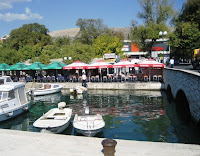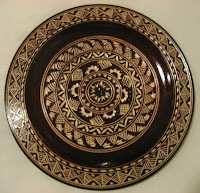 The Mediterranean Cruise Blog continues from the Dalmatian Riviera, as we spent a day in Croatia. This Adriatic city has quite a history. Not only from its recent independence from the former Yugoslavia, but dating back to the days of the Roman Empire, the Emperor Diocletian chose to built a palace for himself as a retirement residence. Even earlier, in 78BC, ancient Romans established a colony in the city of Solono because of its location as a link for trade between the interior lands and the sea. During the Socialist era of this country, there was not a particular value placed on preservation or restoration, so there is an odd combination of heavy industry along what is a beautiful port and coastline. The former government built things like cement and steel factories on top of ancient Roman ruins. It will take many years to gradually move these factories (if ever) to reveal what lies beneath.
The Mediterranean Cruise Blog continues from the Dalmatian Riviera, as we spent a day in Croatia. This Adriatic city has quite a history. Not only from its recent independence from the former Yugoslavia, but dating back to the days of the Roman Empire, the Emperor Diocletian chose to built a palace for himself as a retirement residence. Even earlier, in 78BC, ancient Romans established a colony in the city of Solono because of its location as a link for trade between the interior lands and the sea. During the Socialist era of this country, there was not a particular value placed on preservation or restoration, so there is an odd combination of heavy industry along what is a beautiful port and coastline. The former government built things like cement and steel factories on top of ancient Roman ruins. It will take many years to gradually move these factories (if ever) to reveal what lies beneath.While in Croatia, I learned that there were a few noteworthy things invented here: The ink pen, the design for the parachute, the method for finger printing, torpedoes, and also, my favorite clothing accessory, the cravat.
Despite those blunders of the 1950’s and 1960’s, there is still plenty of old world Medieval charm and beauty to see. We journeyed to see the ruins of the ancient Roman colony of Solona, which is basically piles of stones and ruins in the fields. It is fascinating to envision what the Roman Emperor had built, but it is a bit underwhelming after having seen places like Pompei and the Coliseum in Rome.
 Much more impressive was the Medieval city of Trogir. This walled city has an impressive amount of architecture and sights to see. The entrance to the main cathedral has incredible detail, which is more impressive than the interior in many ways. However, a few hours in Trogir will leave you wanting to see more.
Much more impressive was the Medieval city of Trogir. This walled city has an impressive amount of architecture and sights to see. The entrance to the main cathedral has incredible detail, which is more impressive than the interior in many ways. However, a few hours in Trogir will leave you wanting to see more.The city of Split itself is quite busy, with produce and fish markets, local crafts and plenty of bargain priced shoes, clothes and trinkets to satisfy the most frugal shopper. There is also the old Roman palace, whose under structure now houses souvenir shops galore. If you want to stop for lunch or a coffee, this area is the place to be. Less than a five minute walk from the main port, you can find virtually anything you need. Many small vendors and local shops will accept Euros and US Dollars, although larger stores will require the local Croatian currency, the Kuna.
The weather was perfect for walking, low 70’s and bright sunshine. We stopped at a café to enjoy a Croatian beer while I scribbled out a few postcards. I was pleasantly surprised by Croatia and see the potential this country has to grow as develop. One day I am sure it will be admitted into the EU, which will make things even easier for this tiny but proud nation. Hope you enjoy these photos:

























That is an area about which I know nothing, but your photos make it look so interesting!
ReplyDeleteIt's a good thing you visited Croatia before the general tourist spoilage and rising costs that will occur once it is admitted to the EU. many who have been there say it is like Italy before everyone started buying up Tuscany. And indeed, in the last few years, property prices in Croatia have gone up at least 30%, although still more affordable than Italy.
ReplyDelete